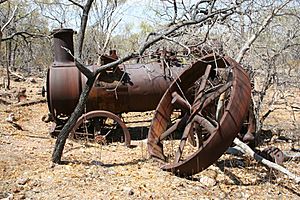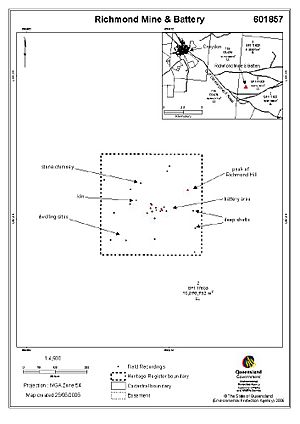Richmond Mine and Battery facts for kids
Quick facts for kids Richmond Mine and Battery |
|
|---|---|

Richmond mine and battery, 2005
|
|
| Location | Gulf Developmental Road, Croydon, Shire of Croydon, Queensland, Australia |
| Design period | 1870s - 1890s (late 19th century) |
| Built | 1886 - c. 1916 |
| Official name: Richmond Mine and Battery | |
| Type | state heritage (built, archaeological) |
| Designated | 28 July 2006 |
| Reference no. | 601857 |
| Significant period | 1880s-1920s circa (fabric, historical) |
| Significant components | shaft, tailings dump, battery/crusher/stamper/jaw breaker, machinery/plant/equipment - mining/mineral processing, incline shaft, mullock heap, kiln, mining camp/settlement site |
| Lua error in Module:Location_map at line 420: attempt to index field 'wikibase' (a nil value). | |
The Richmond Mine and Battery is a special historical mining site in Queensland, Australia. It is located near Croydon on the Gulf Developmental Road. This mine was active from 1886 until about 1916. It mainly produced gold. After 1914, the battery at the mine also crushed tin ore from other nearby mines. Today, it is protected as a heritage site because of its importance to Queensland's history.
Contents
Discovering Gold in Croydon
The Richmond Mine is part of the larger Croydon goldfield. This area is in the Gulf Savannah, about 562 kilometers (350 miles) west of Cairns. Explorers first came to this region in the 1860s. Later, in the 1880s, people started raising sheep here.
The Gold Rush Begins
Gold was first found on Croydon Downs Station in 1883. Two workers found gold in quartz rock. But it was not until 1885 that more gold was found by Richard and Walter Alldridge. They discovered 20 places where gold could be mined.
News of the gold finds spread quickly. On January 18, 1886, the Croydon area was officially declared a goldfield. This meant it was open for mining.
A Boom Town Emerges
Hundreds of people rushed to Croydon hoping to find gold. By 1887, the population of the area grew to 7,000 people. For many years, Croydon was one of the biggest towns in north Queensland. From 1890 to 1910, it produced the second-highest amount of gold in the region.
However, by 1909, gold production started to slow down. By 1914, the population had dropped by half. Mining became more expensive, especially during World War I.
Life on the Goldfield
Miners in Croydon faced many challenges. There was often not enough water, grass for animals, or wood for building and fuel. Being so far away from other towns was also a big problem. This changed when the Croydon to Normanton railway was finished in 1891.
The area also suffered from droughts, floods, and even a cyclone in 1906. During a financial crisis in 1893, many banks closed. This made it hard for miners to sell their gold. Despite these problems, the 1890s were good years for Croydon. Many businesses, like banks, shops, and hotels, opened in the town. Other small mining towns also grew up around Croydon.
The Richmond Mine's Operations
The Richmond gold reef was found on a hill. It was a small but very rich gold deposit. Miners dug deep shafts, some over 118 meters (387 feet) long, to follow the gold.
Between 1886 and 1907, the mine produced a lot of gold. It was considered one of the best mines in the area in the 1890s. Interestingly, much of the work was done by "tributers." These were miners who leased parts of the mine to work for themselves. The mine closed after 1907 because its machinery needed expensive repairs.
Later Years and the Battery
More work happened at the Richmond Mine between 1912 and 1916. The current battery was built in 1913. A battery is a machine that crushes ore to get the gold out. The government helped pay for it with a loan. Parts of the battery came from other mines and a local factory. The year 1913 is even carved into its concrete base.
The battery also crushed ore for other miners, including those from nearby tin mines. By 1915, the mine had a forge (for shaping metal) and engines to power the machinery. The mill shed held a five-stamp battery, which used heavy stamps to crush the ore. It also had other equipment like Wilfley tables, which helped separate gold from crushed rock. Water for the mill came from a dam.
Mining was dangerous work. In 1915, a serious accident happened at the mill. A worker was caught in a drive belt and sadly died. In 1921, the Richmond battery crushed tin ore from the Stanhill tinfield. It is not known exactly when the battery stopped working for good.
What Remains at the Site Today
The Richmond Mine and Battery site is about 10 kilometers (6 miles) east of Croydon. It is in a quiet area with mostly eucalyptus trees. Cattle often graze there.
Mining Structures and Machinery
The main parts of the mine, like the shafts and the battery, are on a hill. You can see where the mine dug into the hillside. There are also large piles of dumped rock, called "mullock," extending down the hill.
The mine site still has a portable steam engine. This engine was connected to a winch, which was used to pull ore and water out of the mine's shafts. You can also see parts of other old machines, including a small single-cylinder engine made by a local company.
The Battery Area
Below the mine, you'll find the battery site. Here, you can see the concrete bases where the five-stamp battery once stood. There are also broken iron parts of the battery frame. Another single-cylinder steam engine is located here. Further down the hill, there's a two-cylinder portable engine with all its wheels still attached.
Other Features of the Site
From the battery, a large pile of crushed waste rock, called a "tailings dump," stretches out. You can also find signs of old living areas where miners might have stayed. These include stone arrangements, broken glass, and pieces of corrugated iron.
An interesting feature is a kiln, or oven, made from a ship's tank and lined with special bricks. This kiln was likely used to melt down gold that had been separated using a chemical process called cyanidation. It's rare to find such a kiln still surviving at a mine site.
Surviving Equipment
Several old machines can still be seen at the Richmond Mine and Battery site:
- A one-cylinder horizontal steam engine made by Stuart & McKenzie in Croydon.
- A two-cylinder portable steam engine made by Robey & Co Engineers in Lincoln, UK.
- A two-drum winding winch (no brand visible).
- Another one-cylinder horizontal steam engine with a flywheel, made by Clark & Faucet Engineers in Brisbane.
- A two-cylinder portable steam engine with four wheels (no brand visible).
Why This Site is Important
The Richmond Mine and Battery was added to the Queensland Heritage Register on July 28, 2006. This means it is a protected historical site.
A Look into Queensland's Past
This site is important because it shows how a small mine in a remote area operated. The old battery and winding machines show how small mines often used second-hand equipment. The different steam engines from local, state, and international makers also tell a story about the technology used at the time. It's a great example of how mines worked on a smaller scale, especially those with rich but scattered gold deposits.
Rare Discoveries
Some parts of the site are quite rare. It's uncommon to find a two-cylinder portable engine with its wheels still intact at an old mining site. The engine made by Stuart & McKenzie might even be the only one of its kind still existing. The kiln used for melting gold from cyanide residues is also a very rare find.
Learning from the Past
The remains of the miners' living areas can teach us a lot about Queensland's history. By studying where the houses were located in relation to the mine and each other, we can learn about daily life and social structures at isolated goldfields in the late 1800s and early 1900s. Looking at the objects found there can also help us understand what people ate, their social status, and their backgrounds.
A Complete Mining Picture
The combination of shafts, rock piles, machinery, and old house sites makes this place very special. The way everything is laid out – the mine on the hill, the crushing plant below, and the kiln further down – shows a typical setup for a complete mining and milling operation in Queensland.
Beautiful and Evocative
The site also has a special feeling about it. Seeing the old mining equipment and workings in the quiet, dry, and isolated landscape creates a powerful and memorable image.


